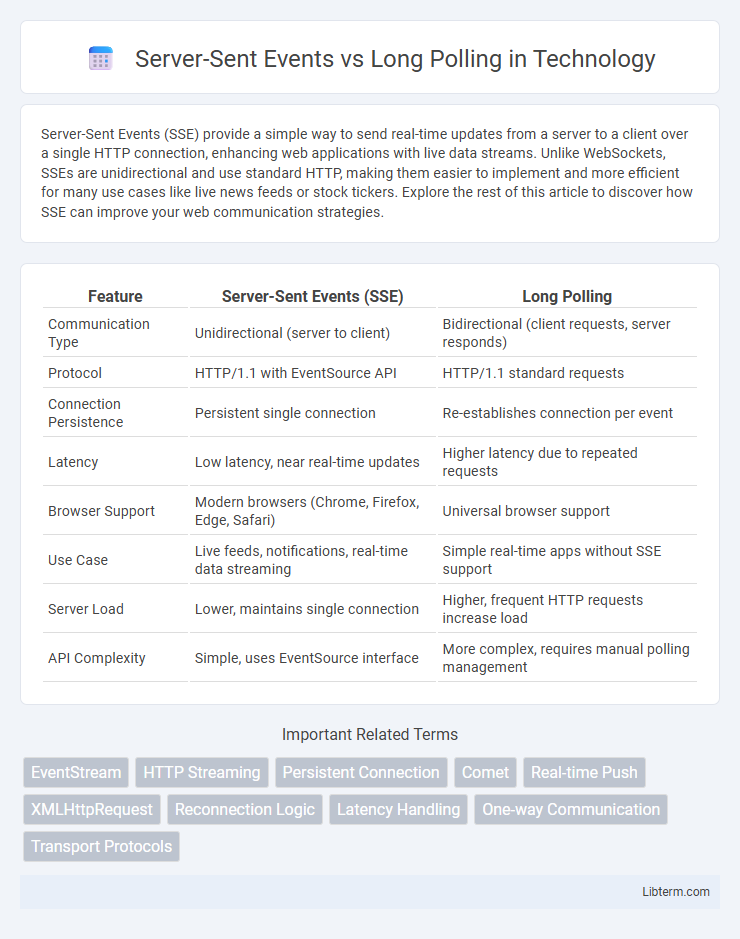Server-Sent Events (SSE) provide a simple way to send real-time updates from a server to a client over a single HTTP connection, enhancing web applications with live data streams. Unlike WebSockets, SSEs are unidirectional and use standard HTTP, making them easier to implement and more efficient for many use cases like live news feeds or stock tickers. Explore the rest of this article to discover how SSE can improve your web communication strategies.
Table of Comparison
| Feature | Server-Sent Events (SSE) | Long Polling |
|---|---|---|
| Communication Type | Unidirectional (server to client) | Bidirectional (client requests, server responds) |
| Protocol | HTTP/1.1 with EventSource API | HTTP/1.1 standard requests |
| Connection Persistence | Persistent single connection | Re-establishes connection per event |
| Latency | Low latency, near real-time updates | Higher latency due to repeated requests |
| Browser Support | Modern browsers (Chrome, Firefox, Edge, Safari) | Universal browser support |
| Use Case | Live feeds, notifications, real-time data streaming | Simple real-time apps without SSE support |
| Server Load | Lower, maintains single connection | Higher, frequent HTTP requests increase load |
| API Complexity | Simple, uses EventSource interface | More complex, requires manual polling management |
Introduction to Real-Time Web Communication
Server-Sent Events (SSE) provide a unidirectional, persistent connection from server to client, enabling efficient real-time data streaming with low latency and reduced overhead compared to Long Polling. Long Polling simulates real-time communication by repeatedly sending HTTP requests that wait for server responses, which increases resource usage and latency. SSE is ideal for applications requiring continuous updates like live news feeds, while Long Polling suits scenarios needing compatibility with older browsers or bidirectional communication.
What Are Server-Sent Events (SSE)?
Server-Sent Events (SSE) enable a web server to push real-time updates to a client over a single, long-lived HTTP connection. SSE uses a unidirectional communication channel where the server continuously sends data streams encoded as text/event-stream, allowing efficient delivery of automatic updates like live scores or stock prices. Unlike Long Polling, which repeatedly opens and closes HTTP connections, SSE maintains an open connection, reducing latency and server overhead for real-time web applications.
Understanding Long Polling
Long Polling is a web communication technique where the client sends a request to the server and keeps the connection open until the server responds with new data or a timeout occurs. This method reduces latency compared to traditional polling by immediately pushing updates as they become available. Long Polling enables near real-time data delivery but can lead to increased server load due to maintaining numerous open connections.
Core Differences: SSE vs Long Polling
Server-Sent Events (SSE) enable a unidirectional, persistent connection where the server continuously pushes updates to the client over a single HTTP connection, resulting in lower overhead and real-time data delivery. Long Polling simulates server push by holding HTTP requests open until new data is available, leading to higher latency and increased network traffic due to repeated request-response cycles. SSE supports automatic reconnection and event IDs for reliable streaming, while Long Polling requires manual handling of reconnections and state management.
Performance Comparison
Server-Sent Events (SSE) provide a more efficient and lower latency solution for real-time data streaming compared to Long Polling by maintaining a single persistent HTTP connection for continuous updates. Long Polling repeatedly opens and closes HTTP connections, leading to higher server overhead, increased network latency, and greater resource consumption. Performance benchmarks demonstrate SSE achieves better scalability and reduced CPU usage under high client loads, making it ideal for applications requiring consistent and timely event delivery.
Scalability and Resource Usage
Server-Sent Events (SSE) enable efficient one-way communication from server to client using a single, persistent HTTP connection, which reduces CPU and memory consumption compared to Long Polling's repeated request overhead. Long Polling continually opens and closes HTTP connections, increasing server resource usage and limiting scalability under high client loads. SSE's lightweight protocol and built-in reconnection mechanism significantly enhance scalability by minimizing connection churn and server load.
Browser and Platform Support
Server-Sent Events (SSE) enjoy broad support in modern browsers, including Chrome, Firefox, Safari, and Edge, but lack native support in Internet Explorer. Long Polling, relying on standard XMLHttpRequest or Fetch APIs, offers universal compatibility across all browsers and platforms, including legacy environments. SSE provides a more efficient solution for real-time updates, while Long Polling ensures fallback capability on platforms where SSE is unsupported.
Security Considerations
Server-Sent Events (SSE) leverage a unidirectional communication model over HTTP/HTTPS, reducing the attack surface compared to Long Polling, which repeatedly opens and closes HTTP connections and may increase exposure to certain types of attacks such as denial-of-service (DoS). SSE supports built-in support for TLS encryption, ensuring data integrity and confidentiality during transmission, while Long Polling requires additional measures to maintain secure, persistent connections. Proper authentication and authorization are critical for both methods; however, Long Polling's frequent handshake overhead presents more opportunities for session hijacking and replay attacks if not managed securely.
Use Cases and Best Scenarios
Server-Sent Events (SSE) are ideal for real-time, unidirectional data streaming such as live news feeds, stock price updates, and social media feeds due to their efficient and low-latency connection over HTTP/1.1. Long Polling excels in scenarios requiring bidirectional communication or when server push functionality is necessary but WebSocket support is unavailable, like chat applications and interactive dashboards. Choosing SSE or Long Polling depends on factors like connection overhead, server scalability, and the need for continuous updates versus request-response patterns.
Conclusion: Choosing Between SSE and Long Polling
Server-Sent Events (SSE) provide efficient, real-time one-way communication from server to client with lower overhead and simpler implementation, making them ideal for live data feeds like news or stock updates. Long Polling, while more resource-intensive due to repeated HTTP requests, supports broader compatibility and bi-directional communication in environments where SSE is unsupported. The choice depends on application requirements for real-time performance, browser support, and server resources.
Server-Sent Events Infographic

 libterm.com
libterm.com